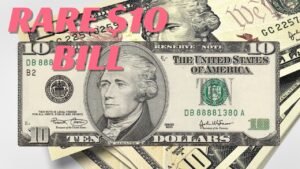In the world of rare currency collecting, some bills are worth far more than their face value — not because of age or gold content, but due to striking printing errors. One such incredible example is a $5 bill with a shifted serial number, which has astonished collectors by fetching more than $540,000 at auction. Yes, you read that right — a single five-dollar bill could be worth a small fortune, and it might still be in circulation.
What Is a Shifted Serial Number?
Every U.S. bill is assigned two serial numbers, printed on either side of the note’s front. These numbers should be perfectly aligned in their designated spaces. A “shifted serial number” refers to an error in which the serial number is significantly misaligned — placed either too far left, right, up, or down. In extreme cases, the serial number might be partly cut off or printed on a non-standard area of the bill.
These types of printing errors are rare and result from a misfeed during the final stages of the printing process at the Bureau of Engraving and Printing.
What Makes This $5 Bill So Valuable?
The mystery lies in a printing error so rare and dramatic that it transforms regular money right into a ancient collectible. This precise $5 invoice capabilities a critically misaligned (shifted) serial quantity, that means the numbers imprinted on the invoice appear particularly out of area — regularly some distance from their ordinary positions or even in part off the invoice’s border.
The most precious instance, which offered for over $540,000, confirmed the serial number shifted to date off-center that it created a one-of-a-type visual flaw — but the rest of the bill remained flawlessly intact. That mixture of blunders and renovation is what makes it so uncommon and acceptable.
How Do Printing Errors Like This Happen?
The U.S. Bureau of Engraving and Printing follows strict best controls, but occasional mistakes happen — in particular at some point of high-speed printing. Currency is outlined in more than one degrees: history, portrait, serial numbers, and seals.
If one of the very last layers — just like the serial variety or treasury seal — is misaligned due to paper misfeed or equipment mistakes, it can bring about a noticeable mistake. While maximum blunders notes are caught and destroyed before leaving the power, a few slip through into movement. These emerge as prized “error notes” inside the world of numismatics.
Could There Be More Still in Circulation?
Yes — and that’s what makes this tale so charming. Many people don’t have a look at their cash intently. A shifted serial wide variety may go overlooked or be dismissed as a printing smudge or minor misprint. But to a educated collector, it is able to be the distinction among $5 and half of one million bucks. Experts accept as true with there are still unknown mistakes notes out there, tucked away in wallets, coins registers, or old envelopes — disregarded and unclaimed.
What to Look for on Your $5 Bills
If you’re curious whether or not your $5 invoice could be this kind of extremely-rare finds, right here’s what to check:
Key Signs of a Valuable Error Bill:
- Serial wide variety is definitely misaligned, tilted, or published too high or low.
- One serial variety fits the invoice, but the other is completely unique or lacking.
- Treasury seal or different features seem out of region or overlapping.
- The bill is uncirculated or in crisp situation — increasing its value.
Even more subtle misprints may be worth loads or lots relying at the rarity and condition.
What to Do If You Find One
- Do not spend it — although it’s “simply” $5.
- Handle it carefully — maintain it flat and keep away from folding.
- Get it authenticated by way of a expert forex grader (like PMG or PCGS Currency).
- Consult with a reputable dealer or public sale residence that specialize in blunders notes.
- Consider having it graded and encapsulated for safety and resale.
Conclusion
While most $5 bills will only ever be worth five dollars, an extremely rare few, like the shifted serial number bill that sold for over $540,000, prove that it pays — quite literally — to look closely. With such notes potentially still in circulation, you might just hold a small fortune in your wallet without even knowing it. So the next time you receive change, take a moment to inspect it carefully — your next big payday might be hiding in plain sight.
FAQ’s
What is a shifted serial number?
It’s a printing errors in which the serial number is particularly out of area — too excessive, low, or tilted.
Could one still be in move?
Yes, a few may have slipped into flow disregarded and could still be found these days.
What need to I do if I find one?
Don’t spend it. Keep it secure and feature it authenticated through a forex grading service like PMG or PCGS.
Why is it well worth a lot?
Its intense rarity, dramatic misprint, and wonderful condition make it incredibly treasured to collectors.
